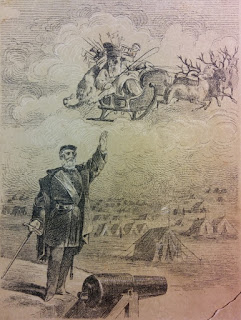The Clements staff are busy packing offices and preparing collections for our move back to campus, an all-encompassing task that makes the days pass far too quickly. We take this opportunity to step back from bubble wrap and boxes to reflect on the magic of the holidays.
The spirit of generosity that characterizes so much of this season is not only reflected in the exchange of gifts and the gathering of loved ones but also in the special efforts to heighten children’s excitement and wonder. Charming letters to Santa can be found in several of our manuscript collections, but it’s less common to see how Santa responded. This undated draft of a poem written by “Santa Claus” reveals some of the thought that went into these exchanges.
 |
| Undated draft poem by “Santa Claus” in our Lars Gustaf Sellstedt family collection. |
“Dear children I’ve come with a pack full of toys / Some presents to leave for all good girls and boys / But I am growing so old, and your chimney’s so small / I fear that I never should get down at all,” Santa worries. His hand-wringing continues as he frets about the changing world he encounters on his yearly trip. “So many fast trolleys horses are running you meet / A quiet old saint dares not drive in the street… Then as to the chimneys they build now-a-days, / They are not made for Santa Claus by a great ways.” Despite his “grumbl[ings],” Santa finishes by admitting that no matter his grievances he would not “be obliged from my darlings to part,” and he promises “my sleigh with its presents shall stop at your door / And whether I come with books, candy, or toys / I’ve heart full of love for my girls and my boys.”
This poem, if left for children to read on Christmas morning, would make Santa Claus feel all the more tangible, as his worries about contemporary road traffic and chimneys connected him to their daily experiences. Another example of how Americans grounded Santa in the historical moment can be found in Louise Clack’s 1867 General Lee and Santa Claus. This volume features a story about three Southern girls arguing about Santa, with one angrily proclaiming “he wasn’t a rebel. I know he wasn’t, for he never came to the Southern children for four Christmas Eves.” Intended to be read by children recovering from the anxieties and traumas of the Civil War, the book acknowledges the hardships experienced in recent years.
 |
| Robert E. Lee waves to Santa in this illustration from General Lee and Santa Claus. Mrs. Louise Clack’s Christmas Gift to Her Little Southern Friends (New York: Blelock & Co., 1867). |
The children write to General Robert E. Lee, a trusted and beloved Confederate figure, to determine whether Santa “was our friend.” The return “letter” from Lee proclaims Santa “one of the best friends that the little Southern girls have,” and explains that he met Santa during the first Christmas Eve of the Civil War, crest-fallen at not being able to travel South to deliver toys on account of the war. He encouraged Santa to instead “take every one of the toys you have back as far as Baltimore, sell them, and with the money you get buy medicines, bandages, ointments and delicacies for our sick and wounded men.” Thus, Santa joins the rank of war heroes and the girls’ worries about paltry Christmases are addressed. Tying Santa to the historical realities of post-bellum children’s lives made him and his magic more believable.
The developing technology of late nineteenth-century photography could also be harnessed to heighten excitement about Christmas. Take, for example, these two stereographs from our Graphics Division.
 |
 |
| F. G. Weller, “Christmas Scenes—No. 282” and an untitled stereograph labeled in manuscript on verso, “Santa Claus- No. 172.” |
These images featuring Santa, one as he prepares to descend the chimney and the second as he enters the home with his pack of toys, could be used with a stereo viewer to see them in three-dimensions. Whether through poetry, literature, or photography, Santa’s plausibility—and the excitement about his visit—surely grew when these media interacted with children’s already vivid imaginations. As these items from the Clements’s collections show, the collective interest in building the season’s wonder has found imaginative outlets through the years, harkening to children’s lived realities to make the magic feel all the more special.
